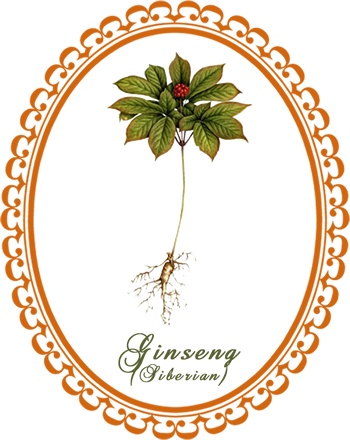
Siberian Ginseng: as an immune-stimulating agent, eleuthero appears to energize the body's defenses, particularly by stimulating specific types of immune cells called helper T-lymphotcytes and natural killer cells...
Common Names: Eleuthero, Siberian Ginseng, Russian Ginseng, Devil's Bush, Touch-me-not, ci wu jia
Botanical Name: Eleutherococcus senticosus
Family: Araliaceae
Plant Type: Deciduous shrub
Parts Used: Roots, stems, bark
Flowering: July
Eleuthero is often called Siberian ginseng because it belongs to the same family, Araliaceae, as true ginsengs (Panax spp.) and like them is considered an adaptogen - a substance that helps the body adapt to stress and is more important for maintaining good health than treating disease. Eleuthero contains eleutherosides which are similar to ginsenosides in the Panax species.
Its native habitat is East Asia, China, Japan and Russia. This variety of ginseng prefers to grow in the forest. E. senticosus is a deciduous shrub growing to 2m at a slow rate. The herb grows in mixed and coniferous mountain forests, forming low undergrowth or is found in groups in thickets and edges. E. senticosus is sometimes found in oak groves at the foot of cliffs, very rarely in high forest riparian woodland.
Description: Eleuthero is a woody shrub with a thick, twisted toot, very prickly stems, and large, palmately divided compound leaves. Umbels (umbrella-like clusters) of tiny inconspicuous flowers are followed by small blue-black berries. The flowers are hermaphroditic and are pollinated by insects.
Cultivation: E. senticosus is broadly tolerant of soils, growing in sandy, loamy and heavy clay soils with acid, neutral or alkaline chemistry and including soils of low nutritional value. Starting new plants from seeds is difficult, as germination is slow and erratic. Most propagation is done by stem and root cuttings. It can tolerate sun or dappled shade and some degree of pollution. It is hardy to zone 3. It flowers in July in most habitats.
Harvesting: The roots are harvested in autumn and dried.
The Russian Tonic
While American astronauts used amphetamines to help their bodies tolerate the stress of being in space, Russian cosmonauts took eleuthero. Soviet athletes used the herb as they trained for the 1984 Moscow Olympics, and excelled in many endurance events. Soon, many Russians, from divers and sailors to miners and explorers, were using eleuthero - anyone whose job and life depended on being able to perform under physically stressful conditions. In 1986, when the Chernobyl nuclear reactor exploded, thousands around and downwind from ground zero were given eleuthero to counter the effects of radiation.
Source: National Geographic Desk Reference to Nature's Medicine by Steven Foster and Rebecca L. Johnson
Herbal Healing with Siberian Ginseng
Medicinal Actions: Adaptogen, antidiabetic, antidote, anti-tumor, demulcent, stimulant, stomachic, tonic
Medicinal Uses: Siberian ginseng is taken as an invigorating tonic, that is recommended for reducing physical and mental stress, alleviating fatigue, improving concentration, and as a performance enhancer under stressful conditions. It normalizes physical functioning depending on what the individual needs, for example it will lower high blood pressure but raise low blood pressure. It produces a protective effect from the stresses of surgery, accidents, certain chemical toxins, radiation and chronic illnesses. It helps the body resist viral infections and environmental toxins, it reduces the frequency, severity, and duration of outbreaks of herpes simplex virus type 2, and slows the replication of viruses causing influenza and the common cold. The immune cell-stimulating effect suggests that eleuthero may prove valuable in long-term treatment of immune system diseases, such as chronic fatigue syndrome, lupus and HIV. During a woman's menopause, it can aid in rejuvenating the body as a whole, balance hormones and regulate hot flashes.
In Chinese medicine, the herb is called ci wu jia and is used for its beneficial effects on the "qi" and it is also used to treat "yang" deficiencies in the kidney and spleen. The root and root bark are used in preparations designed to prevent respiratory infections, colds and flu, and heart ailments. It is used as a tonic to restore vigor and vitality, improve general health, restore memory, promote healthy appetite, and increase stamina.
Contraindications:
- People with high blood pressure, narcolepsy or sleep apnea should not take Siberian ginseng.
- Pregnant and breastfeeding women should also avoid this herb.
- Side effects may include increased blood pressure, insomnia, drowsiness, vomiting, confusion, headache, nosebleed and an irregular heartbeat.
The herb can interact with some prescription medications. If you take Digoxin, it may raise the levels that remain in your bloodstream. This can put you at risk for side effects from this heart medication.
If you are taking sedatives, this can cause interactions with them.
When buying ginseng preparations, read the label carefully. Some are adulterated with Periploca sepium. (Labels should include the ingredients and the amount of each ingredient.)
Preparation and Dosage:
Siberian ginseng preparations are available as extracts, capsules, tablets, powders and dried portions for tea.
The normal recommended dose for using the dried root is 500 to 3,000 mg daily in either herbal tea or capsules.
For tincture, take ½ to 1 teaspoon two or three times per day.
For a standardized extract, take 1—to 200 mg twice a day.
If you appreciate the information provided,
please help keep this website running. Blessings!
© 2008-2025 aromaworx.ca. All rights reserved.

